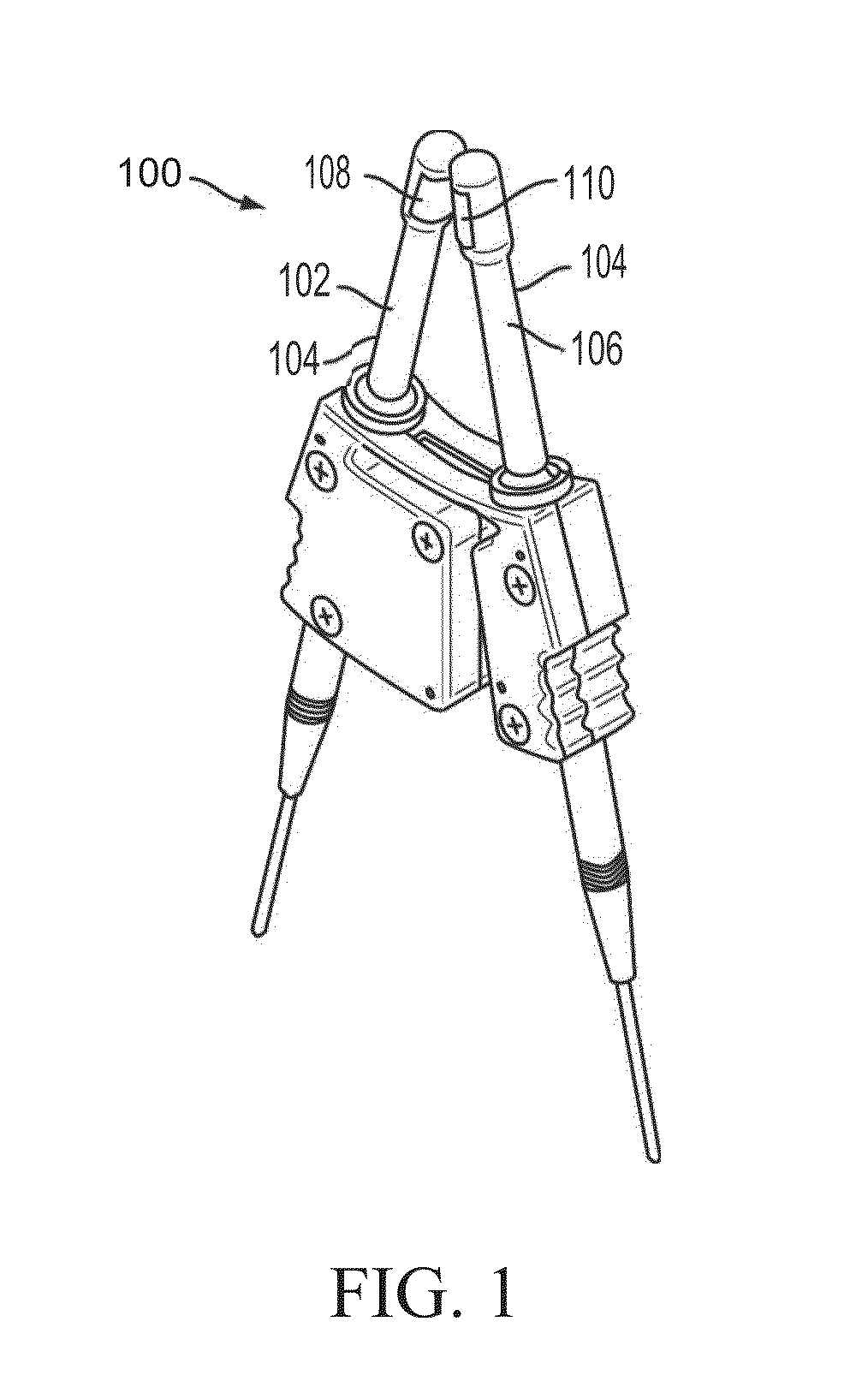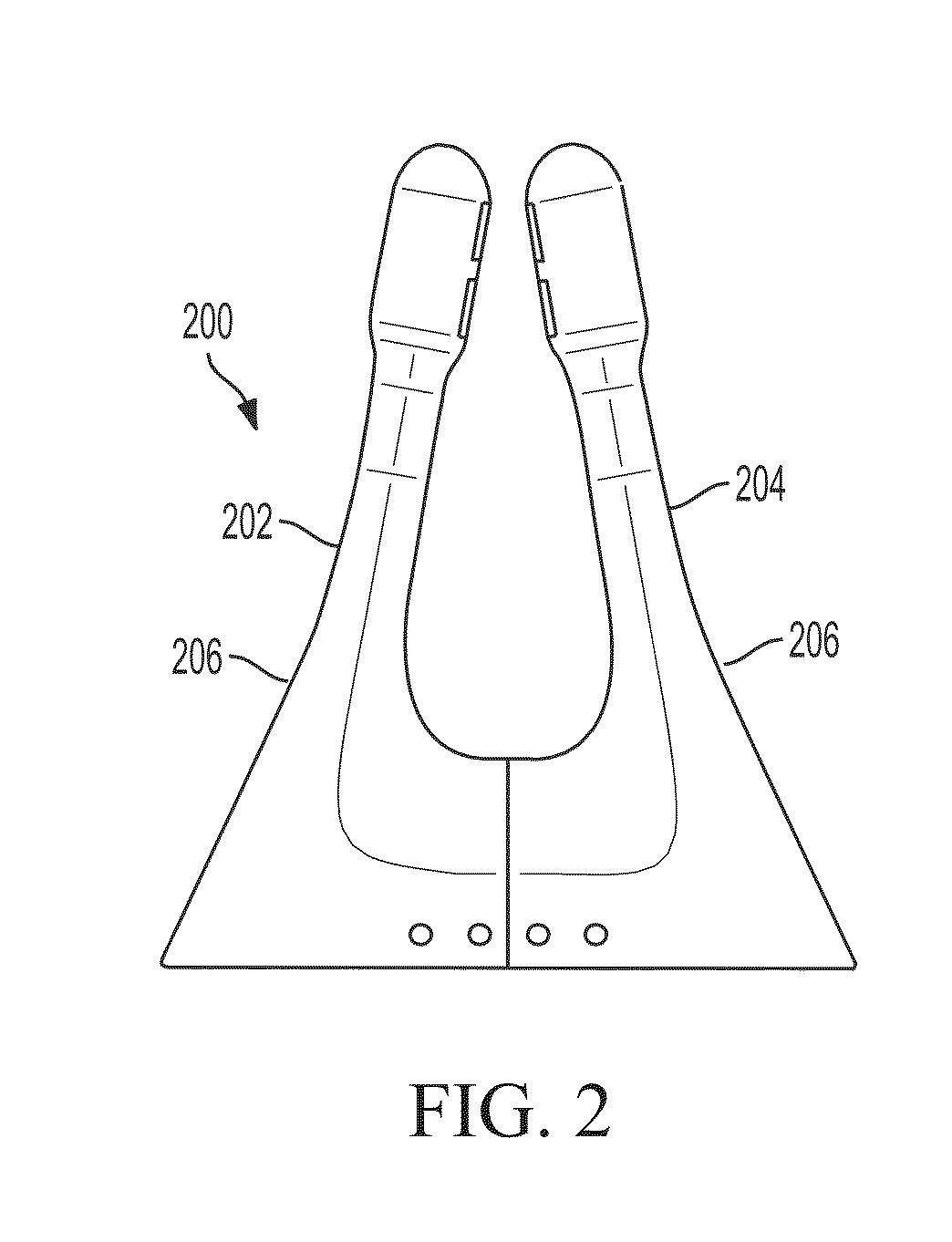Polymer formulations for nasolacrimal stimulation
- Summary
- Abstract
- Description
- Claims
- Application Information
AI Technical Summary
Benefits of technology
Problems solved by technology
Method used
Image
Examples
example 1
Method of Making an Electrically Conductive Hydrogel For Use With a Nasal Stimulator Device
[0119]In a round bottom flask wrapped in aluminum foil and provided with a magnetic stirrer, introduce a first monomer, a second monomer, and a photoinitiator. Additional monomers (e.g., a third or fourth type of monomer, etc.) and / or a diluent may also be added. Clamp the flask on top of a magnetic stirrer / heater that is fitted with a nitrogen purge line. After turning on the magnetic stirrer and nitrogen purge, mix the contents of the flask for five minutes to form a monomer mixture. While the monomers are being mixed, insert sleeves of a nasal device (e.g., sleeve (300) shown in FIGS. 3A-3C) into disposable molds (e.g., as shown in FIG. 4) having windows or louvers that open to let in UV light. The sleeves should be oriented vertically within the molds. Next, draw the monomer mixture from the flask into a syringe and cover the syringe with foil. Attach a needle, e.g., a 30 gauge blunt needl...
example 2
Preparation of a Silicone Hydrogel Including Methacryloxypropyl Tris (trimethoxysiloxy) Silane and Methanol Diluent
[0120]In a round bottom flask wrapped in aluminum foil and provided with a magnetic stirrer, the following was added:
EGMDA (Ethylene glycol dimethacyrlate) (0.081 g)
NVP (N-vinyl pyrollidone) (2.179 g)
GMA (Glyceryl monomethacrylate) (1.112 g)
DMA (Dimethyl acrylamide) (3.917 g)
Methacryloxypropyl tris (trimethyoxysiloxy) silane (2.712 g)
Lucirin (TPO) (0.081 g)
Methanol (2.88 g)
[0121]The flask was clamped on top of a magnetic stirrer / heater that was fitted with a nitrogen purge line. The contents of the flask were then mixed for five minutes to form a monomer mixture. While the monomers were being mixed, the nasal device sleeves and disposable molds were prepared as described in Example 1. The monomer mixture was then drawn into a syringe, injected into the sleeves, and irradiated as described in Example 1. The molds were cooled before removing the sleeves from them.
example 3
Silicone Hydrogel SB1
[0122]Silicone hydrogel formulation SB1 was prepared and molded into sleeves as described in Example 1. The components of the SB1 hydrogel are provided below. A diluent was not included in the SB1 hydrogel formulation.
SB114020 (for kinetic study (formulated on Mar. 13, 2014)molecularmole10 grammolar ratioweightmassfrac-batchto majorMonomers(g / gmole)mole(g)tion(g)monomerwt %HEMA130.140.076810.00000.09640.96060.21529.5299EGDMA198.000.00180.35000.00220.03360.00490.3335NVP111.140.296933.00000.37263.17000.831531.4487DMA99.130.357135.40000.44813.40061.000033.7359allyl methacrylate126.160.00280.35000.00350.03360.00780.3335methacryloxypropyl422.820.059125.00000.07422.40150.165623.8248trisTrimethoxysiloxysilanelucerin348.000.00240.83200.00300.08000.00670.7937Total0.7969104.93201.000010.0800100.0000
PUM
| Property | Measurement | Unit |
|---|---|---|
| Fraction | aaaaa | aaaaa |
| Fraction | aaaaa | aaaaa |
| Fraction | aaaaa | aaaaa |
Abstract
Description
Claims
Application Information
 Login to View More
Login to View More - R&D
- Intellectual Property
- Life Sciences
- Materials
- Tech Scout
- Unparalleled Data Quality
- Higher Quality Content
- 60% Fewer Hallucinations
Browse by: Latest US Patents, China's latest patents, Technical Efficacy Thesaurus, Application Domain, Technology Topic, Popular Technical Reports.
© 2025 PatSnap. All rights reserved.Legal|Privacy policy|Modern Slavery Act Transparency Statement|Sitemap|About US| Contact US: help@patsnap.com



